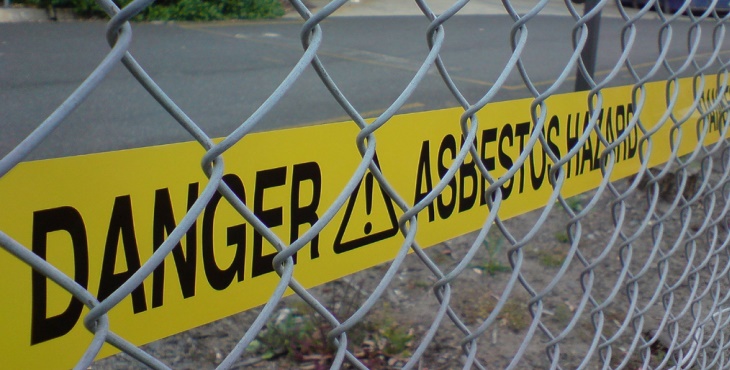Our service members have continuously made the ultimate sacrifice for years, compromising their safety for the betterment of the nation. While the immediate dangers of combat are well-known and understood, there are a slew of secondary risks associated with serving one’s country that we often don’t see on the surface. Some of these dangers develop years after service and are often a new battle of their own. Perhaps one of the most overlooked hazards some Veterans face is asbestos exposure. The invisible and life-threatening mineral is capable of posing a severe health threat to those who come into contact with it and has been tied to several debilitating diseases, including cancer.
What is asbestos?

Due to its fire resistance and durability, asbestos was also a common material used extensively in military operations, particularly within the Navy. Many ships, especially during the WWII era, contained a variety of asbestos-containing products. The boiler and engine rooms of a ship were particularly dangerous because asbestos was widely used as an insulator.
Veterans who lived and worked in tight spaces aboard ships are more at risk since these areas usually had poor ventilation systems. The cramped spaces enabled airborne asbestos to become concentrated, increasing the level of exposure. Asbestos could also be found in many buildings and homes erected prior to 1980. As a result, Veterans may have been exposed to asbestos at different times in their lives, both at work and in their leisure time at home.
Asbestos has been banned in about 60 countries worldwide but isn’t regulated in others, including past conflict zones like Vietnam.
Asbestos-related Illness
The mineral is known for its strength and ability to resist high temperatures and chemical reactions, but the rigid fibers pose a serious danger when asbestos-containing materials are damaged. If these products are broken or eroded, fibers may be released into the surrounding air where they can be breathed in. When asbestos is disrupted and the particles are inhaled, they can become lodged inside the body indefinitely. As the particles settle, they may cause irritation and scarring in the linings of organs such as the lungs, heart or abdomen, eventually leading to a cancer known as mesothelioma. The disease slowly progresses through inflammation, irritation and tumor growth, and includes several other symptoms, including chest pain, tightness, and trouble breathing.
Due to the rareness of the disease, as well as the commonality of its symptoms, it is sometimes misdiagnosed until the cancer has progressed into its later stages. The prognosis for mesothelioma patients is grim, as they are generally given a life expectancy of only 12 to 21 months.
Safeguarding health
While Veterans face many challenges both during and after their service, it is important to remain vigilant about potential asbestos exposure and the dangers it causes. Veterans account for about one-third of all diagnosed mesothelioma cases, so being aware of the disease and its symptoms may help promote early detection and provide patients with the best chance to fight the illness.
Veterans diagnosed with mesothelioma can seek treatment at private cancer centers or at VA-affiliated medical centers which have the capability to treat the disease. Veterans may also be eligible to apply for disability compensation or health care as a result of illnesses caused by asbestos exposure during service.
About the author: Sarah Wallace is a health advocate for the Mesothelioma and Asbestos Awareness Center.
Topics in this story
More Stories
The Social Security Administration is hoping to make applying for Supplemental Security Income (SSI) a whole lot easier, announcing it will start offering online, streamlined applications for some applicants.
Yusuf Henriques, an Army Veteran and former combat medic, is the founder and CEO of IndyGeneUS AI, a genomics company on a mission to improve health equity by increasing representation of women and racial minorities in clinical trials.
Online shopping scams are the riskiest scam for Veterans, with 77.3% of reports confirmed losing money when targeted by this scam.







Peter E Humphries Don’t know what State your in.But in Arkansas you need to see Dr. Christopher John’s
11321 Interstate 30
Ste 306
Little Rock, AR 72209
He is a special Dr in asbestos exposer
Good Luck my friend and
THANK YOU AND ALL THE VETERANS WHO IS SERVING AND SERVED FOR US AMERICANS TO BE FREE
GOD bless you all
USAF Boiler Operations, Maintenance and repairs almost 9 yrs. In Germany (Hahn AB) we replaced damaged, worn brick, block and pipe asbestos. Often hand mixing and application. with our German nationals co-harts. Also abatement at K.I. Sawyer, Barksdale, King Salmon AB and Sheppard AFB’s. Remember getting a physical once and doc said you have a pretty good weez in left lung at one base (forget which now?) Then upon discharge physical and V.A. claim declaration in 1986 The Doc said, “There is not an asbestos award at this time.” remember getting a letter from the V.A. stating the same. Can’t find it at this time. I’m 58 now and often do feel a slight burn and breath shortness also, but have had physicals at V.A. and Private pulmonologists say you do have COPD but don’t really see any asbestos? (Only Xrays have been taken) I was often ankle and shoulder deep in the stuff. Proud to have served!
Peter H. SSGT USAF
Can the people in the Army get it?
What about the Air Force (Aerospace Ground Equiptment Mechanic) in our training, school and machinery such hoses at an Airleft Command Post?
I worked in the Security Police armory at Cam Rahn Bay, RPVN, for a year. Everyone who was issued an M-60 was also issued an asbestos mitt for changing hot machine gun barrels. Us guys in the armory handled the asbestos mitts most, making sure they were in good condition and issuing them to go out on post with M-60’s. How does someone like me prove we handled asbestos everyday?
my pulmonologists, 2 or 3 keep asking me have i been exposed to asbestos i want to file a medical claim for compensation.
michael c delborrell
I was a fireman in the forward engine room aboard the ST. PAUL in 1955-56. Whereas, I wasn’t constantly exposed to asbestos, I did mix it in with plaster of paris repairing tears in the lagging of low and high pressure steam lines. I told VA about the exposure, but the criteria (near death, or terminal) was so strict, I gave up on the issue. I am exhibiting COPD symptoms now, but have no compensation. Xrays, however, show no tumors.
How can I get tested
I have COPD and I was a BOILER TECH. On a WWII destroyer that was still in commition from 1978 to 1981 and the VA denies it.
LOLI
I have Asbestoses due to being exposed in the Navy….. BUT the VBA says it is not severs connected????
But as long as they will not honer my contract with OUR government I being treated for COPD at the VA hospital!!!! and get a CT scans every 6 months!!!!
You should work with the DAV to help get your disability.Their criteria is you need to have asbestos documented on your CT scan,surely you must have that.I was a BT and that is where I was exposed.What dept did you work in ?
Littlerock BTman